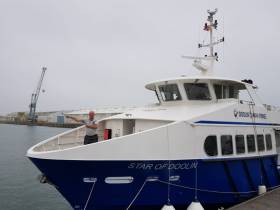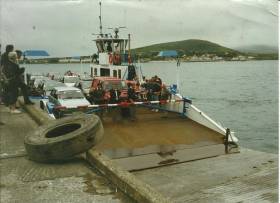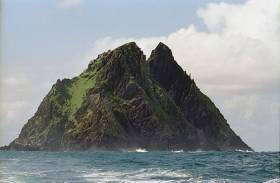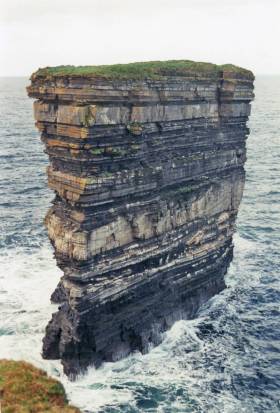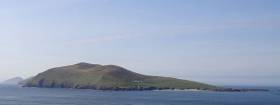Displaying items by tag: Wild Atlantic Way
#IslandNews - Costing €3 million is a new state-of-the-art ferry to serve the Aran Islands which will arrive in Doolin, Co. Clare next week.
The eco-friendly Star of Doolin writes Galway BayFM has been commissioned by the Garrihy’s family run-business, Doolin2Aran Ferries.
The ferry has been built in La Rochelle, France, and will stop in Brest and Dingle before arriving in Doolin at around 8.30am on Tuesday.
Afloat adds that the owners of the 200 -passenger capacity newbuild also operate a sister company, Dublin Bay Cruises with a former west coast islands ferry, St. Bridget.
#CruiseLiners - Ultra-luxury expedition cruiseship, Silver Cloud anchored in Galway Bay recently as part of clockwise tour of Ireland and where today the ship is docked in Killybegs, writes Jehan Ashmore.
The call off the Port of Galway on Tuesday was the second Silverseas Cruises caller. The operator’s new flagship Silver Muse made a visit earlier this month to become the first caller this season.
A flotila of the cruiseships' zodiac tenders took guests ashore to the 'City of the Tribes'. They disembarked at the port's outer pier leading to the entrance of the Dun Aengus dock basin.
Silver Cloud is a Bahamas flagged ship that at 17,014 gross registered tonnes is deemed small today in cruiseship terms, however the Monaco based operator offers luxury at the top end of the market. They have 9 cruiseships and last year the Silver Cloud was refurbished.
According to Silversea, they provide the highest space to guest and crew to guest ratios in expedition cruising. In the case of Silver Cloud there are 257 guests served by a crew 223.
Among the facilities is an explorers’ lounge, bar, boutiques, pool deck, spa, fitness centre and a photo-studio. In addition to the Connoisseur’s Corner offering cognacs and cigars for purchase.
Accommodation consists exclusively of luxurious suites where 80% of them feature verandas.
Prior to making the anchorage call off Mutton Island in Galway Bay, Afloat monitored the ice-class 157m Silver Cloud depart Pembroke Dock, south Wales having sailed from the English Channel.
The cruiseship's first destination following the call to Milford Haven estuary was in Irish waters at the spectacular backdrop of the Skelligs, Co. Kerry. This is where the cruiseship extended its role by offering guests access to 16 zodiacs.
Other water-based equipment includes 16 kayaks opening up opportunities when cruising globally to explore through greater independence.
During the cruise leg from Galway Bay to Killybegs, Silver Cloud yesterday called off the Aran Islands at Kilronan, Inishmore. The anchorage call was followed by another off Clare Island on the approaches to Clew Bay.
The 1994 built cruiseship has since docked in the Donegal port this morning.
Wild Atlantic Way Features In ‘Space Tourism’ Campaign
#StarWars - Tourism Ireland’s latest ad campaign for the Wild Atlantic Way has gone literally stratospheric, as RTÉ News reports.
Skellig Michael is front and centre in what Irish tourism chiefs are calling their ‘first space tourism campaign’, which saw a billboard sent more than 33km skywards on a weather balloon.
The brief clip aims to capitalise on the growing hype for the new Star Wars film The Last Jedi, in which the UNESCO World Heritage site features prominently.
It’s not the first time Tourism Ireland has pushed the Kerry coastal island as a destination for Star Wars fans, and visitor numbers have skyrocketed since it appeared at the end of the previous instalment in the film saga two years ago.
But The Last Jedi, which opens next week, is expected to boost interest in other parts of the Wild Atlantic Way, too, with various scenes shot in picturesque spots between Cork and Donegal.
Newest And Fastest: Doolin-Aran Islands Ferry Enters Service
#NewFastFerry- The newest and largest fastferry between Doolin and the Aran Islands has recently begun operations with reduced sailings times by half, writes Jehan Ashmore.
Introduction of Doolin Express is a major advancement in the upgrade of the fleet for Co. Clare based operators Doolin Ferry. The company earlier this year announced the fastest crossings between Doolin and Inis Oírr, the nearest of the Aran Islands to the mainland.
By spending the day taking in the charms of Inis Oírr there is also on the return trip a stunning cruise under the world famous Cliffs of Moher as part of the Wild Atlantic Way. This is the operators most popular cruise option.
Doolin Express is a boost to services having increased capacity of a single ferry of just 100 passengers to the fastferry's 200. The travel experience of Doolin Express also brings passengers in greater comfort given a state of the art electronic stabilising system. This on board technology is to assist passengers that are prone to motion sickness.
In addition to the fastferry improving efficiencies, the newcomer will work towards meeting the operator’s sustainability and environmental goals.
#MidSizeShip - Astor which at 20,000 tonnes is termed as a mid-sized cruiseship called to Dublin Port today having made a cruise along the Wild Atlantic Way, writes Jehan Ashmore.
A pilot cutter in Dublin Bay came alongside Astor that had sailed overnight from Killybegs. The cruiseship made a leisurely late morning arrival in the port at around 11.30hrs. This compared to the routine majority of dawn arrival calls and mostly undertaken by considerably larger cruiseships.
The Astor was allocated a berth next to the Tom Clarke (East-Link) toll-bridge from where motorist commuters this evening will be able to glimpse the handsome looking vessel until departing at 19.30hrs. Cobh is the next port of call and so the Cork Harbour cruise berth will almost complete a full circumnavigation of the island since Astor called to Bantry on Tuesday.
The 600-only capacity cruiseship with its stylish funnel casing design is operated by German operator Transocean and UK based partner Cruise & Maritime Voyages. Early next month CMV's soon to be replaced flagship Magellen is to make a call to Dublin from Newport. The south Wales port is not normally associated with the cruise sector however Magellan is to make an overnight call.
As for Astor, here's a brief description of facilities. Asides the expected wide range of dinging options, there is a library, card room, internet café and a shopping arcade featuring a boutique, jeweller and perfumery. There is the Wellness Centre offering hairdressing and beauty treatments, an indoor swimming pool, ocean view gym, sauna and massage facilities.
Apart from Bantry Bay from where another smaller ship Serenissima recently opened the season at west Cork location, Astor also headed into the Shannon Estuary to Foynes. Notably the mid-west port is infrequently used by the cruise sector despite its accessible deep waterway.
A sister of Astor, Saga Pearl II but operating for Saga Cruises has also offered cruisegoers to experience less well known ports and or are less accessible to larger deep drafted ships. In the case of Saga Pearl II a call was made to Warrenpoint and given its location requires a passage up Carlingford Lough presenting a mountainous coastal backdrop. The call to the Co. Down port was the first ever by a cruiseship and this took place in 2014.
Also further along the Down coast is another beauty spot, Strangford Lough, where the aforementioned Serenissima called to Portaferry yesterday. This call by Serenissima Cruises follows their opening of the cruise season in Dun Laoghaire Harbour on Wednesday.
Fred Olsen have also offered cruisegoers in recent years to visit less well explored ports in Irish and UK waters among them Barrow-in-Furness in Cumbria. More of their mid-sized cruiseships will be seen throughout Irish waters as the season begins to get busier this month.
#ValentiaFerry - There are concerns over the future of the Valentia Island carferry service as the vessel of more than 50 years will no longer meet marine safety requirements, reported RTE Six One News.
Islanders of the Co. Kerry island say that tourism would collapse if State funding is not met to fund a replacement ferry that is expected to cost in the region of €3 million. The figure is beyond the reach of the island community, however the operator of the ferry, Valentia Island Ferries say they can contribute €1m but they are seeking State assistance for the remaining €2m.
The service linking Reenard on the mainland to Knightstown on Valentia Island only takes seven minutes, was established by five island families in 1996. Richard Foran of Valentia Island Ferries said that last year they carried 100,000 cars and that represented around 250,000 passengers.
While the island can be accessed by a bridge on the western end, the islanders and tourist alike benefit from the ferry service that reduces the distance to Cahersiveen by 13 miles. The loop created is according to the islanders essential to the Skellig Ring and the Wild Atlantic Way.
Skellig Ring Makes Top 10 World Travel Regions
#SkelligRing - The Skellig Ring in Co Kerry features in Lonely Planet’s top 10 regions for globetrotters to explore on 2017.
“Ireland’s most charismatically wild and emerald stretch of coastline,” as the popular travel guide’s Best in Travel report puts it, rounds out a list that includes such breathtaking destinations as French Polynesia, Chilean Patagonia, mountainous New Zealand and the Azores.
And unsurprisingly, the biggest draw to this corner of the Wild Atlantic Way is the majestic Skellig Michael, set for another bumper tourism year in 2017 on the back of its inclusion in the new Star Wars movie series.
Portuguese Man O’ War Sightings Prompt Calls For Coastal Caution
#MarineWildlife - Sightings of the deadly Portuguese man o’ war along the West Coast have prompted calls for caution among coastal users, especially surfers and other beachgoers.
TheJournal.ie yesterday reported that as many as 15 of the toxic sea organisms that resemble jellyfish had been spotted on various beaches in Co Mayo and Co Clare.
Further sightings have been made along the Wild Atlantic Way as far south as Co Kerry and as far north as Donegal, according to The Irish Times, which carries Dr Tom Doyle’s warning for the public to steer clear of any specimens they might discover washed up on the shore.
The marine biologist with NUI Galway’s Ryan Institute emphasised that the creatures harbour seriously painful stings in their blue tentacles that have even killed three people worldwide.
Sea Stack Scaled By Adventurous Climbers For First Time In 25 Years
#SeaStack - A famous sea stack off the Co Mayo coast has been climbed for the first time in more than 25 years, as Independent.ie Travel reports.
At the end of August, Iain Miller and his climbing partner Paulina Kaniszewska reached the top of Dún Briste, off Downpatrick Head, in what was the third attempt by the former to summit the 50m rock.
One of the more breathtaking spots along the Wild Atlantic Way, it's also considered a particularly dangerous climb that should only be attempted by experts.
But for Miller, the rewards for scaling the summit of a place that has seen fewer visitors on record than men on the moon were more than he could put into words.
Independent.ie Travel has more on the story HERE.
#WildAtlanticWay - Minister of State for Tourism Patrick O’Donovan has announced almost €1.125 million in funding from Fáilte Ireland’s Capital Grants Allocation for two key projects along the Wild Atlantic Way.
A grant of is being made available to Galway County Council will receive €896,000 for the Connemara Greenway, while a grant of €225,000 is being allocated to the Office of Public Works (OPW) towards the first phase of development of new visitor facilities on Great Blasket Island.
“I am delighted to announce these grants today as these two important tourism attractions will provide a serious contribution to the future success of the Wild Atlantic Way," said the minister last Wednesday (13 July).
"Tourism moves in a very competitive global market and capital development is one means by which we can ensure that we are fighting fit to win a good portion of overseas visitors and, thereby, gain a return on this investment through increased revenue and jobs regionally.”
The grant for the Connemara Greenway will fund a new section of the route from Cloonbeg to Athry, running adjacent to Ballynahinch Castle, with a view to completion in May 2017.
This development is part of a wider plan for the Clifden to Oughterard Greenway that will link up with the planned Greenway from Galway city to Oughterard – ultimately resulting in a 78km Galway to Clifden Greenway offering a cycling experience from city to coast with international appeal for cycling enthusiasts.
The Blasket Centre, meanwhile, is located on the Wild Atlantic Way at the halfway point of the Slea Head Drive on the Dingle Peninsula. It was developed as a heritage and visitor centre honouring the unique community who lived on the remote Blasket Islands until 1953.
Currently there are no visitor facilities on the island but the new grant will assist the OPW in their overall development of the site by funding new facilities and services on the island, expected to be completed later this summer.
“These grants are an investment in the visitor experience on the ground," said Fáilte Ireland chief executive Shaun Quinn. "While the Wild Atlantic Way has been warmly received at home and abroad, it is still an evolving project. It is vital that we continue to invest in the project to ensure that we open up its full potential.
"We have great natural landscapes along the west coast but we must also ensure that we have top class tourism infrastructure, whether facilities or interpretation, to match them.”
Minister O’Donovan also recently launched a new Fáilte Ireland Grants Scheme for Large Tourism Projects, which will provide a pool of €65 million in investment to develop new, or boost existing, tourism experiences and attractions across Ireland.
The scheme, which will run from 2016-2020, is now open for applications from the public, private and voluntary sectors including community groups. Under the scheme, capital grants in excess of €200,000 and up to a maximum of €5 million will be available.


























